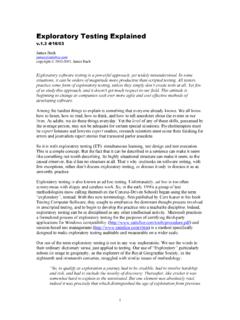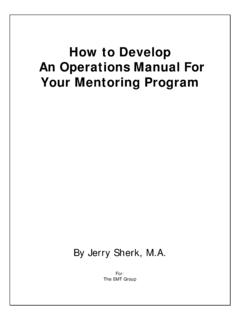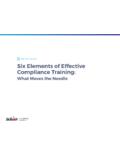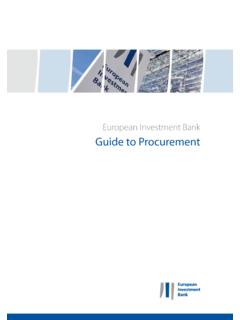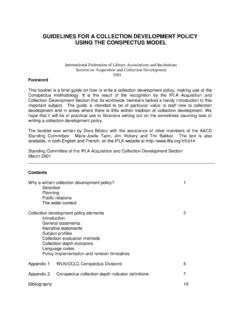Transcription of Project Environment Product Elements
1 - 1 - Designed by James Bach Version 5/20/2015 Copyright 1996-2015, Satisfice, Inc. The heuristic Test Strategy Model is a set of patterns for designing a test strategy. The immediate purpose of this model is to remind testers of what to think about when they are creating tests. Ultimately, it is intended to be customized and used to facilitate dialog and direct self-learning among professional testers. Project Environment includes resources, constraints, and other Elements in the Project that may enable or hobble our testing. Sometimes a tester must challenge constraints, and sometimes accept them. Product Elements are things that you intend to test. Software is complex and invisible. Take care to cover all of it that matters, not just the parts that are easy to see. Quality Criteria are the rules, values, and sources that allow you as a tester to determine if the Product has problems.
2 Quality criteria are multidimensional and often hidden or self-contradictory. Test Techniques are heuristics for creating tests. All techniques involve some sort of analysis of Project Environment , Product Elements , and quality criteria. Perceived Quality is the result of testing. You can never know the "actual" quality of a software Product , but through the application of a variety of tests, you can make an informed assessment of it. - 2 - General Test Techniques A test technique is a heuristic for creating tests. There are many interesting techniques. The list includes nine general techniques. By general technique we mean that the technique is simple and universal enough to apply to a wide variety of contexts. Many specific techniques are based on one or more of these nine. And an endless variety of specific test techniques may be constructed by combining one or more general techniques with coverage ideas from the other lists in this model.
3 Function Testing Test what it can do 1. Identify things that the Product can do (functions and sub-functions). 2. Determine how you d know if a function was capable of working. 3. Test each function, one at a time. 4. See that each function does what it s supposed to do and not what it isn t supposed to do. Claims Testing Challenge every claim 1. Identify reference materials that include claims about the Product (implicit or explicit). Consider SLAs, EULAs, advertisements, specifications, help text, manuals, etc. 2. Analyze individual claims, and clarify vague claims. 3. Test the veracity of each claim about the Product . 4. If you re testing from an explicit specification, expect it and the Product to be brought into alignment. Domain Testing Divide and conquer the data 1. Look for any data processed by the Product . Look at outputs as well as inputs. 2. Decide which particular data to test with.
4 Consider things like boundary values, typical values, convenient values, invalid values, or best representatives. 3. Consider combinations of data worth testing together. User Testing Involve the users 1. Identify categories and roles of users. 2. Determine what each category of user will do (use cases), how they will do it, and what they value. 3. Get real user data, or bring real users in to test. 4. Otherwise, systematically simulate a user (be careful it s easy to think you re like a user even when you re not). 5. Powerful user testing is that which involves a variety of users and user roles, not just one. Stress Testing Overwhelm the Product 1. Look for sub-systems and functions that are vulnerable to being overloaded or broken in the presence of challenging data or constrained resources. 2. Identify data and resources related to those sub-systems and functions. 3. Select or generate challenging data, or resource constraint conditions to test with: , large or complex data structures, high loads, long test runs, many test cases, low memory conditions.
5 Risk Testing Imagine a problem, then look for it. 1. What kinds of problems could the Product have? 2. Which kinds matter most? Focus on those. 3. How would you detect them if they were there? 4. Make a list of interesting problems and design tests specifically to reveal them. 5. It may help to consult experts, design documentation, past bug reports, or apply risk heuristics. Flow Testing Do one thing after another 1. Perform multiple activities connected end-to-end; for instance, conduct tours through a state model. 2. Don t reset the system between actions. 3. Vary timing and sequencing, and try parallel threads. Automatic Checking Check a million different facts 1. Look for or develop tools that can perform a lot of actions and check a lot things. 2. Consider tools that partially automate test coverage. 3. Consider tools that partially automate oracles. 4. Consider automatic change detectors.
6 5. Consider automatic test data generators. 6. Consider tools that make human testing more powerful. Scenario Testing Test to a compelling story 1. Begin by thinking about everything going on around the Product . 2. Design tests that involve meaningful and complex interactions with the Product . 3. A good scenario test is a compelling story of how someone who matters might do something that matters with the Product . - 3 - Project Environment Creating and executing tests is the heart of the test Project . However, there are many factors in the Project Environment that are critical to your decision about what particular tests to create. In each category, below, consider how that factor may help or hinder your test design process. Try to exploit every resource. Mission. Your purpose on this Project , as understood by you and your customers. Do you know who your customers are?
7 Whose opinions matter? Who benefits or suffers from the work you do? Do you know what your customers expect of you on this Project ? Do you agree? Maybe your customers have strong ideas about what tests you should create and run. Maybe they have conflicting expectations. You may have to help identify and resolve those. Information. Information about the Product or Project that is needed for testing. Whom can we consult with to learn about this Project ? Are there any engineering documents available? User manuals? Web-based materials? Specs? User stories? Does this Product have a history? Old problems that were fixed or deferred? Pattern of customer complaints? Is your information current? How are you apprised of new or changing information? Are there any comparable products or projects from which we can glean important information? Developer Relations. How you get along with the programmers.
8 Hubris: Does the development team seem overconfident about any aspect of the Product ? Defensiveness: Is there any part of the Product the developers seem strangely opposed to having tested? Rapport: Have you developed a friendly working relationship with the programmers? Feedback loop: Can you communicate quickly, on demand, with the programmers? Feedback: What do the developers think of your test strategy? Test Team. Anyone who will perform or support testing. Do you know who will be testing? Do you have enough people? Are there people not on the test team that might be able to help? People who ve tested similar products before and might have advice? Writers? Users? Programmers? Are there particular test techniques that the team has special skill or motivation to perform? Is any training needed? Is any available? Who is co-located and who is elsewhere? Will time zones be a problem?
9 Equipment & Tools. Hardware, software, or documents required to administer testing. Hardware: Do we have all the equipment you need to execute the tests? Is it set up and ready to go? Automation: Are any test tools needed? Are they available? Probes: Are any tools needed to aid in the observation of the Product under test? Matrices & Checklists: Are any documents needed to track or record the progress of testing? Schedule. The sequence, duration, and synchronization of Project events Test Design: How much time do you have? Are there tests better to create later than sooner? Test Execution: When will tests be executed? Are some tests executed repeatedly, say, for regression purposes? Development: When will builds be available for testing, features added, code frozen, Documentation: When will the user documentation be available for review? Test Items. The Product to be tested.
10 Scope: What parts of the Product are and are not within the scope of your testing responsibility? Availability: Do you have the Product to test? Do you have test platforms available? When do you get new builds? Volatility: Is the Product constantly changing? What will be the need for retesting? New Stuff: What has recently been changed or added in the Product ? Testability: Is the Product functional and reliable enough that you can effectively test it? Future Releases: What part of your tests, if any, must be designed to apply to future releases of the Product ? Deliverables. The observable products of the test Project . Content: What sort of reports will you have to make? Will you share your working notes, or just the end results? Purpose: Are your deliverables provided as part of the Product ? Does anyone else have to run your tests? Standards: Is there a particular test documentation standard you re supposed to follow?
